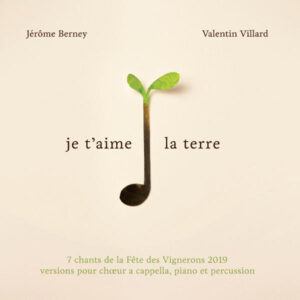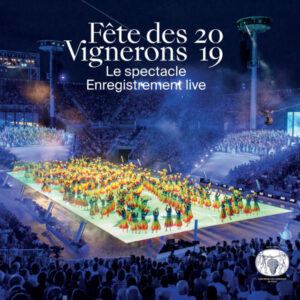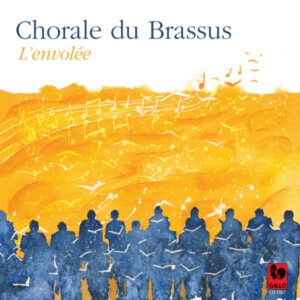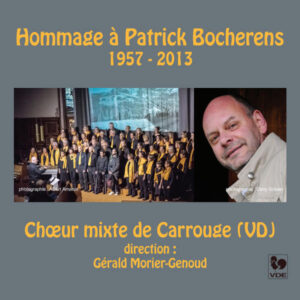Extraits / Excerpts
Ce Théâtre qui Chante - Choeur du Théâtre du Jorat - Robert Mermoud
René MORAX / Gustave DORET: Henriette: Soleil de juin – Henriette: Je m’en vais au petit jour – Henriette: Petit jardin plein d’ombre – Jean VILLARD-GILLES / Jean BINET: La Grange aux Roud: La terre a reverdi – La Grange aux Roud: Aujourd’hui c’est dimanche – La Grange aux Roud: La maison – Samuel CHEVALLIER / Robert MERMOUD: Le Silence de la Terre: Seul – Le Silence de la Terre: Les heures – René MORAX / Arthur HONEGGER: Le Roi David, H 37, Part. 3: Mort de David – René MORAX / Gustave DORET: Aliénor: Heureux celui qui revoit sa patrie – Aliénor: Chanson d’Aliénor – La Servante d’Evolène: Dans la prairie l’herbe a fleuri – La Servante d’Evolène: La neige fond sur les montagnes – La Servante d’Evolène: Je ne veux pas du vieux mari – Henri-Charles TAUXE / Robert MERMOUD: Le Chevalier de Grandson: Tant vous aime – Le Chevalier de Grandson: Je vous choisis (Othon de Grandson) – Le Chevalier de Grandson: Ma bonne terre – Géo Henri BLANC / Heinrich SUTERMEISTER: Le Buisson ardent: J’ai contemplé la montagne
Chœur du Théâtre du Jorat, Robert Mermoud, Conductor. https://theatredujorat.ch/
Yvonne Perrin, Soprano
Pierre-André Blaser, Tenor
Catherine Eisenhoffer, Harp
Bruno Hoffmann, Glass Harp
THE THÉÂTRE DU JORAT
In 1903, to celebrate the 100th anniversary of the Canton of Vaud’s foundation, residents of Mézières decided to create a dramatic work with choral elements. This work, La Dîme, by the young and then little-known author René Morax, met with great success.
Following this success and after being asked to write the text for the 1905 Fête des Vignerons, for which Gustave Doret composed the music, Morax, Doret, and other collaborators, including the painter Jean Morax, decided to establish a popular rural theater. Encouraged by the writer Romain Rolland, this initiative led to the construction of the entirely wooden Théâtre du Jorat in Mézières, with a capacity of 1,100 seats and a stage measuring 25 meters wide. It opened in 1908 with a reprisal of La Dîme and a new work, Henriette, both with music by Doret.
The theater’s mission has been largely creative, premiering many Swiss works over its 70-year history. Notably, it staged Gluck’s Orpheus in 1911 with the patronage of Saint-Saëns and other figures. Several works, such as Aliénor (1965) and Le Roi David (a world-famous oratorio by Morax and Honegger), became part of its core repertoire.
In 1978, Le Chevalier de Grandson by Henri-Charles Tauxe, with music by Robert Mermoud, marked another success. The founders intended the theater to be a popular institution, supported by volunteer performers and widespread community involvement.
René Morax expressed a wish late in life for the theater to continue its tradition of offering true and moving works, which unite audiences. This wish has been honored, as demonstrated by the ongoing success of the theater’s performances.
THE CHOIR OF THE THÉÂTRE DU JORAT
In 1975, for the revival of La Servante d’Evolène, the Committee of the Théâtre du Jorat asked me to form a choir composed of singers from the region, in line with the original mission of this popular theater. For many years, indeed, a conductor was hired for each performance, who would come with their own troupe. This is how we had the opportunity to hear La Chanson valaisanne, the Union Chorale of Vevey, that of La Tour-de-Peilz, the Chœur de Lausanne, the Chœur Pro Arte, and the Chœur of the Swiss Radio, the Lyre of Moudon, and the Chœur of the École Normale of Lausanne, with conductors such as Georges Haenni, Carlo Hemmerling, Hans Haug, André Charlet, Pierre Chatton, Jean-Jacques Rapin, and myself.
After a first attempt with the creation of the Grand Chœur du Jorat for the revival of Aliénor in 1965, the goal was to establish a permanent choir, limited in size but of high quality. Personally, having too often lamented the static nature of some stagings, I wanted an ensemble that was absolutely reliable, capable of performing in the most diverse and dispersed formations. For some pieces, it is essential to seek dynamic or dramatic effects, for example by having one half of the choir respond to the other half. It must be possible to mix the voices to the extreme, spreading them across the vast stage area, while bearing in mind that despite the wonderful acoustics, the voices carry less when placed beyond the stage’s edge.
After a call for singers was made in the region, with the collaboration of Anne-Marie Monnier and Frank Cherpillod, and following various invitations, the choir gradually stabilized at around fifty singers. Vocal quality, dedication, enthusiasm, and camaraderie are the defining traits of these singer-actors, whose authenticity shines in this rustic setting. They succeed in delivering refined yet unaffected performances.
After La Servante d’Evolène and the 1976 concerts featuring reprises of the incidental music from Romeo and Juliet (Frank Martin) and La Grange aux Roud (Jean Binet), and after Le Chevalier de Grandson, for which I composed the score, here is now this recording with some of the greatest choral works written for the Théâtre du Jorat. This impressive repertoire is a testament to the rapidity of the work, the effort of memorization, the discipline, and the total commitment of a tightly-knit team determined to defend one of the finest artistic ventures in our country.
Robert Mermoud
- Categories
- Composers
- Interprets
- Booklet












